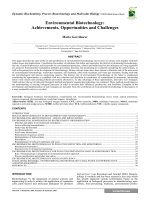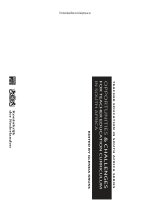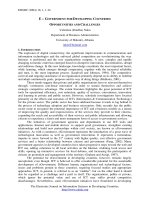TPP opportunities and challenges for vietnamese enterprises EN
Bạn đang xem bản rút gọn của tài liệu. Xem và tải ngay bản đầy đủ của tài liệu tại đây (1009.75 KB, 28 trang )
THE TRANS-PACIFIC PARNERSHIP NEGOTIATIONS (TPP)
OPPORTUNITIES AND CHALLENGES FOR
VIETNAMESE ENTERPRISES
Ho Chi Minh City WTO Affairs Consultation Centre
July 2013
Content
1. Context and preferences
2. Content negotiations and notes about the
TPP
3. Opportunities and challenges
4. Some recommendations
Context and preferences
The WTO Doha Round impasse à strengthen
bilateral and regional FTAs
The dynamic development of the Asia –
Pacific
The development/evolution of APEC; Role of
ASEAN increasingly important and
substantive
Redirecting the U.S attention to Asia
Free Trade Agreements between Asia
countries and Americas countries
Source:
www.coha.org
Negotiating process between the two largest
commercial institutions
RCEP (ASEAN+6)
CHINA
India
Japan
South Korea
Indonesia, Myanmar,
Thailand, Cambodia,
Philippine, Laos
ASEAN
Australia
New Zealand
Vietnam
Singapore
Malaysia
Brunei
TPP
USA
Canada
Mexico
Chile
Peru
Preferences
Australia, Brunei, Chile, Canada,
Malaysia, Mexico, New Zealand,
Peru, Singapore, U.S, Vietnam
TPP 9
TPP11
TPP13
TPP
2009
2011
2013
RCEP
ASEAN+6
China, India,
Japan, Australia
Korea New Zealand
2015
Free Trade
Area Asia Pacific
(FTAAP)
Preferences
Together towards a target for free trade in the
Asia Pacific region:
Trans-Pacific - TPP: Comprehensive, opportunities
and challenges, influence of the U.S.
Or East Asia (Asian Regional Comprehensive
Economic Partnership Agreement - RCEP):
focusing on trade; ASEAN is central, but China's
influence.
Vietnam attended both, but preferred choice in
which direction?
NOTES ON TPP
Comprehensiveness: including many fields, not only
commerce but also sensitive areas
Modernity: applying international standards towards the
21st Century template
Openness: opening for all countries
Point of view of the United States: not lower than FTAs
of U.S
Opening investment and services by "negative
approach“ (more opened and transparent)
Problem: Why the main content cannot be transparent
in the negotiation process?
Content of TPP negotiating
The main contents: 22 group issues
Some featured content, sensitive, controversial:
Ø Commodity trade: Tax cuts almost entire, but Rules of
Origin strict
Ø Investment problem: by negative approach, but
opening the possibility of settling disputes between
investors and the government à increased costs
Ø Intellectual Property: TRIPS+ or ++? à Controversial
in a some industries: pharmaceutical, information...
Ø Government Procurement: Vietnam is a new WTO
observer à opportunities to use capital efficiently or
challenge the state-owned enterprises?
Ø State-owned enterprises: still heavy, even greater
proportion
Ø Labor, unions: rights and interests of workers and
wider; or competition issues
Ø Technical Barriers (TBT, SPS): consumer benefits,
but may lead to disguised protectionism
Ø Anti-corruption, environmental protection and other
issues.
à Many new problems, need to control issues arise
during execution
à Essentially the issue of competition, how to balance
the benefits?
OPPORTUNITIES AND CHALLENGES
Income gains by country
(gains from trade and FDI)
GDP ($bill)
Australia
Brunei
Canada
Chile
Japan
Korea
Malaysia
Mexico
New
Zealand
Peru
Singapore
United
States
Vietnam
TPP
Economies
Others
World
Slide 11
2025
1,426
22
1,982
289
5,332
2,063
422
1,999
206
311
386
20,337
235
35,010
66,957
101,967
Income gain ($bill)
TPP
5
0
7
4
53
19
12
12
2
8
2
39
36
200
-‐27
173
FTAAP
13
0
12
7
115
71
25
42
3
9
6
143
66
512
687
1,199
% GDP
TPP
0.4
0.9
0.4
1.5
1.0
0.9
2.7
0.6
1.0
2.5
0.6
0.2
15.5
0.6
0.0
0.2
FTAAP
0.9
1.8
0.6
2.3
2.2
3.4
6.0
2.1
1.4
2.9
1.6
0.7
28.0
1.5
1.0
1.2
Smaller
economies get
largest % gains
Source: Pro. Peter
A.Petri, Brandeis
University, America
2012
Export changes
Baseline
Primary
products
Rice
Wheat
Other
agriculture
Mining
2025
Change
in
exports
$bill.
Asian
Two
track
tracks
TPP
FTAAP
17.5
2.1
0.0
4.4
11.1
-‐1.6
-‐0.3
0.0
-‐0.5
-‐0.8
0.3
0.1
0.0
0.2
0.0
-‐0.9
-‐0.1
0.0
-‐0.2
-‐0.5
-‐2.1
-‐0.1
0.0
-‐0.5
-‐1.5
Manufactures
Food,
beverages
TexWles
Apparel,
footwear
Chemicals
Metals
Electrical
equipment
Machinery
Transport
equipment
Other
manufactures
241.1
21.7
28.5
130.1
6.0
3.7
16.1
10.9
2.1
22.0
70.6
-‐2.6
14.3
60.3
-‐0.9
-‐0.7
2.3
-‐0.9
-‐0.3
-‐0.9
34.7
-‐0.4
5.5
26.0
0.1
-‐0.3
4.0
0.4
0.1
-‐0.8
85.2
-‐1.6
15.2
67.7
-‐0.5
-‐0.7
6.1
-‐0.2
-‐0.1
-‐0.8
117.1
-‐4.8
23.9
95.1
-‐0.6
-‐1.2
8.3
-‐1.0
-‐0.3
-‐2.3
Services
UWliWes
ConstrucWon
Trade,
transport,
comm.
Private
services
Public
services
Total
5.1
0.0
0.8
1.1
3.2
0.0
263.8
-‐1.1
0.0
-‐0.1
-‐0.2
-‐0.7
0.0
68.0
-‐0.5
0.0
0.0
-‐0.1
-‐0.5
0.0
34.5
-‐1.1
0.0
0.0
-‐0.2
-‐0.8
0.0
83.3
-‐1.7
0.0
0.0
-‐0.4
-‐1.3
0.0
113.4
Three
largest
Source: Pro. Peter
A.Petri, Brandeis
University, America
2012
U.S. Market Penetration
Source: amcham
vietnam.com
Opportunities (1)
Identify opportunities ahead:
Increased
investment
Increased (FDI)
Export
Decreased
tariffs, trade
barriers
Increased
GDP/income
Opportunity to improve the business environment
Vietnam's business environment improved after joining
WTO, but deteriorated in the last few years
Year
Rank
Year
Rank
2005
98/175
2009
93/183
2006
104/175
2010
78/183
2007
91/178
2011
98/183
2008
92/181
2012
99/183
Source: World Bank
Does the TPP may be new pokes for institutional
improvement?
Opportunities (2)
Important opportunities in the long term
Institutional
reform
Perfecting
the legal
system
Improve the
business
environment
Developed
in the
direction of
modern,
civilization
Barriers to opportunities (1)
Opportunity to increase exports: yes or no?
Which sectors benefit most from tax cuts:
Textiles
Footwear…
Increasing opportunities/attracting investment
Joining the global value chain
Conditions to turn opportunities into reality:
Origin
Meet the conditions of the environment, labor
More…
à Not readily have the opportunity
Case study: Textiles
Export to the U.S accounted ½ ; the tax rate reduction
from 7% to 0%
Vietnam has many advantages in term of textile, but
import 86,7% the fabric à ROO “yarn forward” from
TPP countries is a challenge.
In chain: fiber - yarn - fabric - dyed / finished - cut/sew,
actually Vietnam only strong final stage.
Negotiating intermediate product list that Vietnam and
the TPP countries cannot meet and route (2 lists)
However, "yarn forward" can stimulate the investment
in Vietnam remains weak phases? à Opportunities
for textile industry participating in global value chain.
Practical lessons of Vietnam – Japan FTA: “fiber
forward”?
Barriers to opportunities (2)
Human factors and inertia:
Ø Habits / law-abiding consciousness
Ø Corruption and reform resistance
Ø Differences in political/cultural/developmental level
à Become challenge (internal problems)
Examples of some “sensitive” issues:
Government procurement: enhanced efficiency
intellectual property à Sense of business and residents
State-owned enterprises à need real reform
Labor, environmental, technical standards…à the new
standard is higher than
When meet / compliance à become an opportunity to
reform the next important
Challenges
1.
2.
Applying new standards in the TPP
From nicely target, but the problem is competitive and
benefits
Ex: Intellectual property, technical barriers (including
labor and environment), the interests of investors…
Differences in TPP countries
Institutional /mode and orientation
Development level
Vietnam is one of the countries is quite different
Compare income of TPP countries
70,000
60,000
50,000
40,000
30,000
20,000
10,000
-
Source: Estimates by PPP
April 2013 (IMF)
GDP of all TPP countries
Malaysia
2%
Canada
5%
Australia
4%
Singapore
1%
Peru
1%
Việt Nam Chile
1%
1%
New Zealand
1%
Brunei
0%
Hàn Quốc
6%
Mexico
6%
Hoa Kỳ
56%
Nhật Bản
16%
GDP 2012/PPP: billion USD
Source: CIA (2012 estimate)
Equality competition?
Find competitive advantage to expand export markets
Open domestic services market
à Chance of consumers; and attempt to survive,
development of domestic enterprises
4. Cost of business
The challenge from non-commercial factors increase
cost of business
3.
Overall
1. TPP is to pursue and exchanged?
The immediate benefit is not really easy, but long-
term vision for the TPP will boost reforms
Institutional reform in business, improve investment
environment à long term benefits for business
Due to the business environment in Vietnam is not
complete, need real reform dynamics
Cannot missed to take opportunity to negotiate
2. The correlation between opportunities and
challenges
In opportunities there will be challenges and vice
versa
To have opportunity, to overcome challenges/
conditions; faced and overcome these challenges will
bring greater opportunities
Nothing à will only challenges









